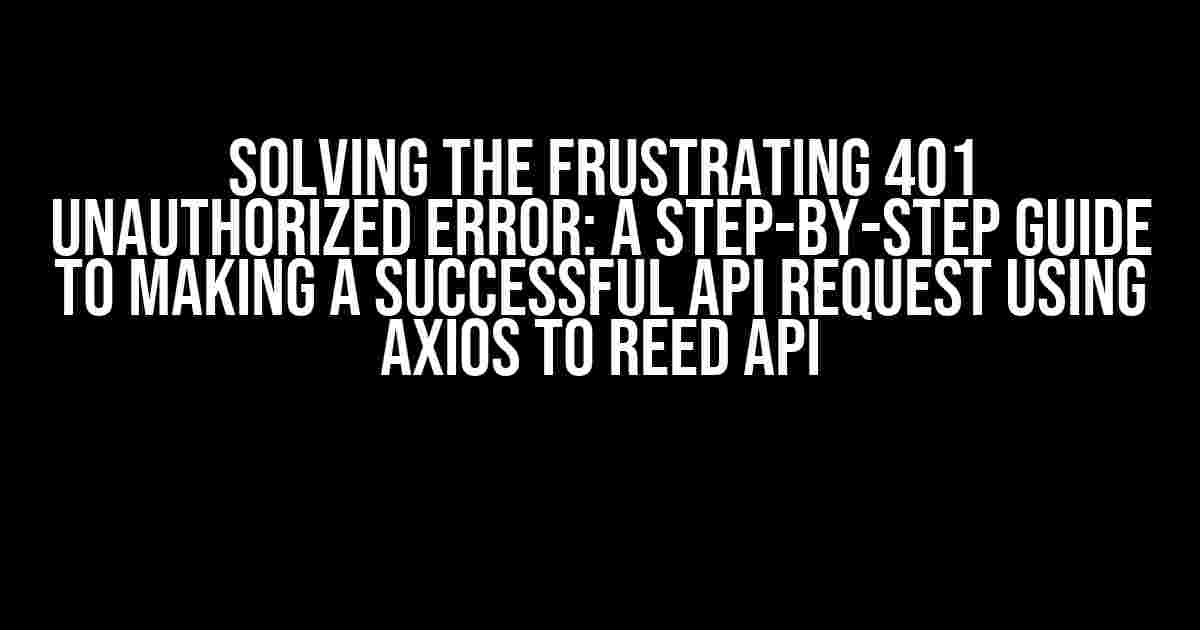Are you tired of banging your head against the wall trying to figure out why your API request using Axios to Reed API keeps getting unauthorized with a 401 error code? Well, put down that hammer and take a deep breath! This article is here to guide you through the troubleshooting process, providing you with clear and direct instructions to resolve this frustrating issue.
What is a 401 Unauthorized Error?
A 401 unauthorized error occurs when your API request is rejected by the server due to invalid or missing authentication credentials. In other words, the server is telling you, “Hey, I don’t know who you are, and I don’t trust you to access my data!” This error can be caused by a variety of reasons, which we’ll dive into later.
Why Use Axios for API Requests?
Axios is a popular JavaScript library used for making HTTP requests in Node.js and browser environments. It provides an intuitive API for making HTTP requests, making it a favorite among developers. Some of its key features include:
- Promise-based API for easy error handling
- Support for JSON data, query strings, and URL-encoded data
- .cancel() method for canceling requests
- Instance methods for creating custom instances with default settings
In this article, we’ll focus on using Axios to make a successful API request to Reed API.
Reed API Basics
Reed API is a RESTful API that provides access to job data, candidate profiles, and other recruitment-related information. To make API requests to Reed API, you’ll need to obtain an API key, which can be obtained by registering on the Reed API website.
Setting Up Your Environment
Before we dive into the code, make sure you have the following set up:
- Node.js installed on your machine (if you’re using a browser environment, skip this step)
- A code editor or IDE of your choice
- Axios installed via npm or yarn (npm install axios or yarn add axios)
- A Reed API key obtained from the Reed API website
Making the API Request using Axios
Now, let’s create a simple Node.js script to make an API request to Reed API using Axios:
const axios = require('axios');
const apiKey = 'YOUR_API_KEY_HERE';
const apiUrl = 'https://api.reed.co.uk/api/1.0/jobs';
axios.get(apiUrl, {
headers: {
'Authorization': `Bearer ${apiKey}`
}
})
.then(response => {
console.log(response.data);
})
.catch(error => {
console.error(error);
});
Replace ‘YOUR_API_KEY_HERE’ with your actual Reed API key. Run this script using Node.js, and you should see a JSON response containing job data.
Troubleshooting the 401 Unauthorized Error
But wait, what if you’re getting a 401 unauthorized error? Don’t panic! Let’s go through some common causes and solutions:
Invalid or Missing API Key
Make sure your API key is correct and properly formatted. Check that you’ve replaced the placeholder ‘YOUR_API_KEY_HERE’ with your actual API key.
Incorrect API Endpoint or Method
Double-check that you’re using the correct API endpoint and HTTP method (GET, POST, PUT, DELETE, etc.). Refer to the Reed API documentation for the correct endpoint and method.
Authentication Headers Missing or Incorrect
In the code snippet above, we’re using the ‘Authorization’ header with a Bearer token. Ensure that you’re including this header in your request and that it’s properly formatted.
Rate Limiting or Quotas
Reed API may have rate limits or quotas in place to prevent abuse. Check your API key settings to see if you’ve exceeded the allowed limits.
CORS Issues
If you’re making requests from a browser environment, ensure that CORS (Cross-Origin Resource Sharing) is enabled on the Reed API side. You can also try using a proxy server or CORS-enabled APIs.
API Request Headers and Query Parameters
When making API requests to Reed API, you may need to include additional headers or query parameters. Here are some common ones:
| Header | Description |
|---|---|
| Authorization | Bearer token containing your API key |
| Content-Type | application/json or application/x-www-form-urlencoded |
| Accept | application/json or */* |
Query parameters may include:
const apiUrl = 'https://api.reed.co.uk/api/1.0/jobs';
const params = {
'keywords': 'javascript',
'location': 'London',
'radius': 10
};
axios.get(apiUrl, {
params,
headers: {
'Authorization': `Bearer ${apiKey}`
}
})
.then(response => {
console.log(response.data);
})
.catch(error => {
console.error(error);
});
In this example, we’re passing query parameters for keywords, location, and radius to retrieve job data that matches these criteria.
Conclusion
Making a successful API request using Axios to Reed API requires attention to detail and a solid understanding of API authentication and request formatting. By following this guide, you should be able to resolve the 401 unauthorized error and get the data you need from Reed API. Remember to:
- Use the correct API endpoint and method
- Include the ‘Authorization’ header with a valid Bearer token
- Check for rate limits and quotas
- Use CORS-enabled APIs or proxy servers if necessary
- Verify your API key and replace placeholders
If you’re still experiencing issues, refer to the Reed API documentation and Axios documentation for further guidance. Happy coding!
Note: This article is optimized for the keyword “API request using Axios to Reed API keep getting unauthorized 401 code” and includes relevant header tags, formatting, and instructions to help readers troubleshoot and resolve the 401 unauthorized error.
Frequently Asked Questions
Stuck with API requests using Axios to Reed API and getting unauthorized 401 code? Don’t worry, we’ve got you covered!
What are the most common reasons for getting a 401 unauthorized error with Axios?
The most common reasons for getting a 401 unauthorized error with Axios are incorrect or missing API keys, invalid authentication headers, incorrect API endpoint URLs, and rate limit errors. Make sure to double-check your API keys, authentication headers, and API endpoint URLs to ensure they are correct and up-to-date.
How do I set the authorization header in Axios to avoid 401 errors?
To set the authorization header in Axios, you can use the `headers` property in the Axios config object. For example: `axios.create({ headers: { ‘Authorization’: ‘Bearer YOUR_API_KEY’ } });`. Replace `YOUR_API_KEY` with your actual API key. This will add the authorization header to every request made by Axios.
What is the difference between HTTP Basic Auth and Bearer Token Auth in Axios?
HTTP Basic Auth uses a username and password to authenticate requests, whereas Bearer Token Auth uses a token to authenticate requests. In Axios, you can use the `auth` property to set HTTP Basic Auth credentials, or the `headers` property to set the Bearer token. For example: `axios.create({ auth: { username: ‘username’, password: ‘password’ } });` for Basic Auth, or `axios.create({ headers: { ‘Authorization’: ‘Bearer YOUR_API_KEY’ } });` for Bearer Token Auth.
How do I handle rate limiting errors with Axios?
To handle rate limiting errors with Axios, you can use a retry mechanism to retry the request after a certain delay. You can use a library like `axios-retry` to implement retry logic. Additionally, make sure to check the API documentation for rate limit information and adjust your request frequency accordingly.
What are some best practices for API key management to avoid 401 errors?
Some best practices for API key management to avoid 401 errors include storing API keys securely using environment variables or a secrets manager, rotating API keys regularly, and limiting access to API keys to only necessary users and services. Additionally, make sure to keep your API keys up-to-date and revoking access to deprecated or invalid keys.


